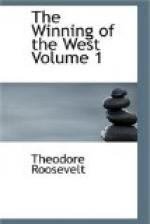This northwestern land lay between the Mississippi, the Ohio, and the Great Lakes. It now constitutes five of our large States and part of a sixth. But when independence was declared it was quite as much a foreign territory, considered from the standpoint of the old thirteen colonies, as Florida or Canada; the difference was that, whereas during the war we failed in our attempts to conquer Florida and Canada, we succeeded in conquering the Northwest. The Northwest formed no part of our country as it originally stood; it had no portion in the declaration of independence. It did not revolt; it was conquered. Its inhabitants, at the outset of the Revolution, no more sympathized with us, and felt no greater inclination to share our fate, than did their kinsmen in Quebec or the Spaniards in St. Augustine. We made our first important conquest during the Revolution itself,—beginning thus early what was to be our distinguishing work for the next seventy years.
These French settlements, which had been founded about the beginning of the century, when the English still clung to the estuaries of the seaboard, were grouped in three clusters, separated by hundreds of miles of wilderness. One of these clusters, containing something like a third of the total population, was at the straits, around Detroit.[9] It was the seat of the British power in that section, and remained in British hands for twenty years after we had become a nation.
The other two were linked together by their subsequent history, and it is only with them that we have to deal. The village of Vincennes lay on the eastern bank of the Wabash, with two or three smaller villages tributary to it in the country round about; and to the west, beside the Mississippi, far above where it is joined by the Ohio, lay the so-called Illinois towns, the villages of Kaskaskia and Cahokia, with between them the little settlements of Prairie du Rocher and St. Philip.[10]
Both these groups of old French hamlets were in the fertile prairie region of what is now southern Indiana and Illinois. We have taken into our language the word prairie, because when our backwoodsmen first reached the land and saw the great natural meadows of long grass—sights unknown to the gloomy forests wherein they had always dwelt—they knew not what to call them, and borrowed the term already in use among the French inhabitants.
The great prairies, level or rolling, stretched from north to south, separated by broad belts of high timber. Here and there copses of woodland lay like islands in the sunny seas of tall, waving grass. Where the rivers ran, their alluvial bottoms were densely covered with trees and underbrush, and were often overflowed in the spring freshets. Sometimes the prairies were long, narrow strips of meadow land; again they were so broad as to be a day’s journey across, and to the American, bred in a wooded country where the largest openings were the beaver meadows and the clearings of the frontier settlers, the stretches of grass land seemed limitless. They abounded in game. The buffalo crossed and recrossed them, wandering to and fro in long files, beating narrow trails that they followed year in and year out; while bear, elk, and deer dwelt in the groves around the borders.[11]




